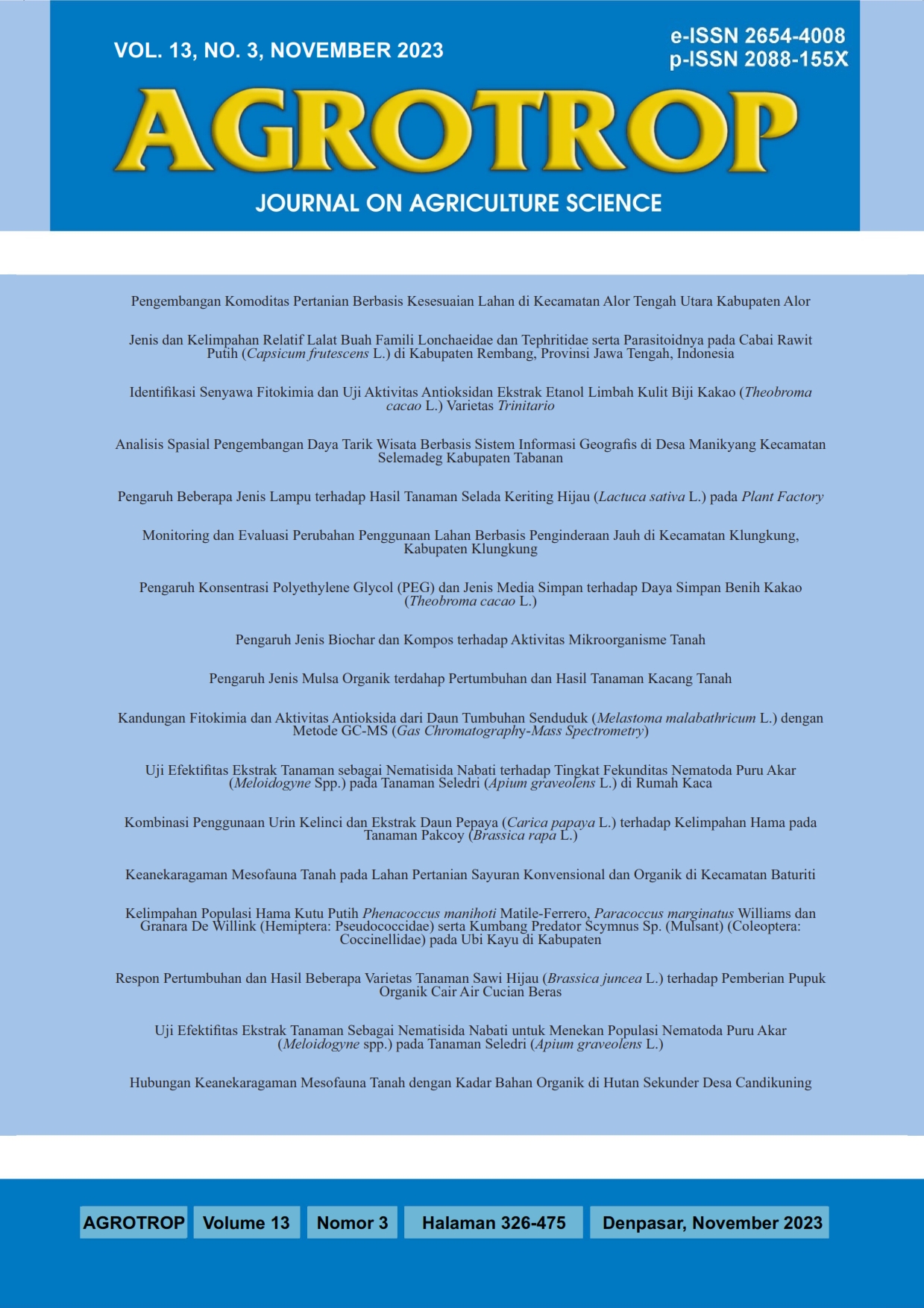Uji Efektifitas Ekstrak Tanaman Sebagai Nematisida Nabati untuk Menekan Populasi Nematoda Puru Akar (Meloidogyne spp.) pada Tanaman Seledri (Apium graveolens L.)
Abstract
Testing the Effectiviness of Plant Extracts as Botanical Nematicides to Suppress the Population of Root Knot Nematodes (Meloidogyne spp.) on Celery Plants (Apium graveolens L.). Root knot nematodes (Meloidogyne spp.) are one of nematodes that attack various types of important agricultural crops. This nematode is found on plant roots and can cause symptoms such as stunting, root knot, and wilting in plants. One effort to control nematodes is to use botanical nematicides. Based on this, research will be carried out to suppress the population of root knot nematodes (Meloidogyne spp.) using plant leaf extracts of Marigold (Tagetes spp.), soursop (Annona muricata L.), papaya (Carica papaya L.), neem (Azadirachta indica), and jatropha plant (Jatropha curcas L.). The research methods are: (1) Making plant leaf extracts, (2) Making solution of Meloidogyne spp., (3) Testing the ability of several plant leaf extracts in pots/polybag. The purpose of this study was to determine the plant leaf extracts were able to suppress the population of Meloidogyne spp. The results showed that the nematode population/300 g soil, Tagetes spp. extracts was the best in suppressed the population, 22,2 mesh (75,3%), Jatropha curcas L. 25,4 mesh (71,7%), Carica papaya L. 28,0 mesh (68,8%), Azadirachta indica 31,6 mesh (64,8%), dan Annona muricata L. 34,0 mesh (62,2%). In calculating the nematodes population/1 g of root, it is Tagetes spp. the best extract suppressed the population of root knot nematode, namely 21,2 mesh (69,5%), Jatropha curcas L. 24,0 mesh (65,5%), Carica papaya L 27,4 mesh (60,6%), Azadirachta indica 30,8 mesh (55,7%), dan Annona muricata L. 33,4 mesh (52,0%).
Downloads
References
Browning, M, Wallace, DB, Dawson, C, Alm, SR & Amador. JA. 2006, Potential of butyric acid for control of soil-borne fungal pathogens and nematodes affecting strawberries, Soil Biol. Biochem. 38(2):401–404.
Dropkin, V.H. 1991. Introduction to Plant Nematology. Second Edition. Departemen of Plant Phathology. University of Missouri. Columbia. Diterjemahkan oleh Supratoyo. 1996. Pengantar Nematologi Tumbuhan. Edisi Kedua. UGM Press. Yogyakarta.
Dubbey, N.K., R. Shukla, A. Kumar, P. Singh, and B. Prakash. 2010. Prospects of Botanical Pesticides in Sustainable Agriculture. Current Science 4 (25): 479-480.
Gommer. 1973. Nematicidal Principles in Compositae. Dissertation. Wageninga Agic. Univ. The Netherlands. 73 pp.
Heyne, K. 1987. Tumbuhan Berguna Indonesia. Jilid III. Badan Litbang Kehutanan. Jakarta.
Javed, N., Gowen, S. R., Inam-ul-Haq, M., Abdullah, K., & Shahina, F. 2006. Systemic and persistent effect of neem (Azadirachta indica) formulations against root-knot nematodes, Meloidogyne javanica and their storage life. Crop Protection, 26(7), 911-916.
Kardiman, A. 2001. Pestisida Nabati Ramuan Dan Aplikasi. PT. Penebar swadaya. Jakarta.
Khan, Z; Kim, YH, Kim, SG & Kim, HW. 2007. Observations on the suppression of root-knot nematode (Meloidogyne arenaria) on tomato by incorporation of cyanobacterial powder (Oscillatoria chlorina) into potting field soil. Bioresource Technol. 98(1),69–73.
Khater, HF. 2012. Prospects of botanical bio-pesticides in insect pest management. Journal of Applied Pharmaceutical Science 2(5):244–259.
Lopez. 2005. In Vitro Effect Of Condosed Tannins From Tropical Fodder Crops AgaintsEggs And Larvae Of TheNematoda Haemunchus contortus. Journal of Food, Agriculture and Environment(2): 191-194.
Mustika, I., dan A. Rahmat. 1994. Efikasi Beberapa Macam Produk Cengkeh Terhadap Nematoda Lada. Prosiding Seminar Hasil Penelitian dalam Rangka Pemanfaatan Pestisida Nabati, Bogor. Badan Penelitian dan Pengembangan Pertanian. Balittro. Hlm. 49-55.
Nwokocha, A., Blessing, I. O., Agbagwa, I. O., & Okoli, B. E. 2011. Comparative phytochemical screening of Jatropha L. species in the Niger Delta. Research Journal of Phytochemistry, 5(2), 107-114.
Oostenbrink, M. 1966. Evaluation and integration of nematode control methods.
Oudejans, H. 1991. Agro-Pesticides Properties and Functions in Integrated Crop Protection. United Nations Bangkok.
Prasasti, W. D. 2012. Strategi Pengendalian Penyakit Nematoda Puru Akar (Meloidogyne spp.) pada Tanaman Tomat (Solanun lycopersicum L.). Yogyakarta (ID): UGM Press.
Sangwan, N.K., B.S. Verna, K.K Verma, and K.S. Dhindsa. 1990. Nematicidal Activity of Some Essential Plant Oils.
Sastrautomo, Soetikno. S., 1990. Ekologi Gulma. P.T Pustaka Utama: Jakarta.
Sayre, R.M. 1980. Promosing Organism for Biological Control of Nematodes Plant Disease 64 : 527-532.
Setiawati, W., R. Murtiningsih, N. Gunaini dan T. Rubiati. 2008. Tumbuhan Bahan Pestisida Nabati dan Cara Pembuatannya untuk Pengendalian Organisme Penganggu Tumbuhan (OPT). Pusat Penelitian Dan Pengembangan Hortikultura Badan Penelitian dan Pengembangan Pertanian Balai Penelitian Tanaman Sayuran. Diakses pada tanggal 26 Maret 2021.
Setyawaty. D. 2002. Studi Pengaruh Ekstrak Daun Sirih (Piper battle Linn.) dalam Pelarut Aquades, Etanol, dan Metanol Terhadap Perkembanga Larva Nyamuk Culex quinquefasciatus. Skripsi. Fakultas Kedokteran Hewan. Institut Pertanian Bogor.
Tariq, R.M., S.N.H. Naqvi, M.I. Choudhary, and A. Abbas. 2010. Importancedan Implementation of Essential Oil of Pakistanian Acorus calamus Linn., as a biopesticide. Pakistinian J.
Wallace, H.R. 1971. Dalam Wisnuwardhana W.A. 1978. The Biology of Plant Parasitic Nematodes. Edward Arnold Ltd. London. 280 p. Diakses pada tanggal 23 Maret 2021.
Wisnuwardhana, W.A. 1978. Hubungan Antara Tingkat Populasi Awal dari Meloidogyne spp. dan Kerugian Produksi Tanaman Tomat. Bul. Penelitian Hortikultura. Vol VI. No. 1. Bogor. P 21-29.











